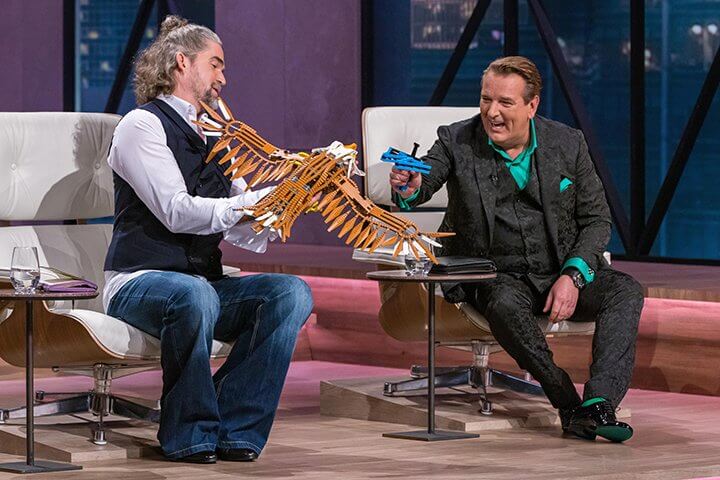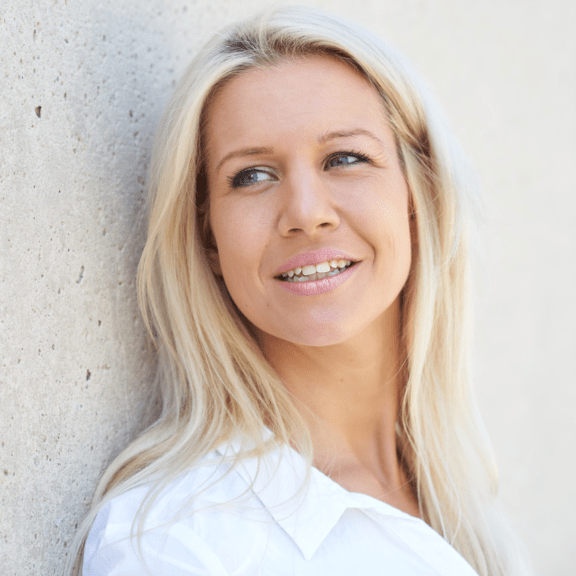Bionic: The difficult decision of the licence business #DHDL
In many cases, it seems clear what the best business model should look like. The product type, market, target group or the interplay of such factors often dictate at least the cornerstones from the outset. Sometimes, however, there are several options, and a decision in favour of a particular business model has a lot to do with your own values and ideas, but also with your ambitions. Just how difficult such a decision can be is demonstrated by the start-up C-bionic in "Die Höhle der Löwen".
Freitag,
10.05.2024

As we all know, the TV lions have already seen a lot. So it’s not that easy to really amaze and inspire them. But founder Marcel Pasternak has actually managed it: with his bionics-inspired modular construction systems, which contain both static and innovative flexible components, he captured the attention of the experienced investors from the very beginning.
The 35-year-old inventor has made it his mission to familiarise children with bionics with the help of innovative play sets. In contrast to the well-known building blocks on the market, his sets imitate nature, and in addition to building instructions for two different animals or biological mechanisms, the accompanying booklet also contains a lot more information about them. The aim is to make learning fun and arouse curiosity.
The lions are immediately enthusiastic, and after extensive testing, the figures are quickly analysed. The sales prices and margins are very well received, and the previous turnover of €60,000 would probably not have been criticised if the valuation had been a little lower. However, the founder is asking €320,000 for 10%, which means a post-money valuation of €3.2 million.
This is too high for Lioness Janna Ensthaler and she leaves the negotiation relatively early.
Carsten Maschmeyer and Dagmar Wöhrl express similar criticism and call on the founder to make further concessions, whereupon he increases his offer to 15%. You can clearly sense the interest of the lions who have not yet exited, but for the time being they are not really being specific.
Nils Glagau then introduces the final phase with his question about what he expects from an investor, as the founder responds with his desire for sales support. However, he also announces that the €320,000 will not be enough for him, as he needs a further €500,000 in working capital to be able to handle production and logistics in sufficient quantities.
Carsten Maschmeyer then pulls out, also on the grounds that the valuation is now even too high for him, as he includes the working capital costs in full. Of course, this is debatable, as working capital normally flows into the company in the form of loans – i.e. borrowed capital – but of course it cannot be completely ignored, as the investor in question is taking on considerably more risk.
But there is still plenty of movement among the lions. Dagmar Wöhrl had already spoken to Nils Glagau, as both saw licence deals with large toy manufacturers as an opportunity for C-bionic. The Orthomol boss therefore also asked whether the founder had already thought about it. He answered in the affirmative, but clearly rejected all licence ideas: he envisaged distribution via the company’s own brand and was not swayed by Dagmar Wöhrl’s enquiries, who then left.
Nils Glagau also says goodbye soon afterwards, but refers back to the evaluation.
But why is the founder so vehemently opposed to licensing his patented building blocks? Because a licence model is often a very „convenient“ business model, as it can lead to good earnings with relatively little effort. In this case, for example, the patented flexible bricks could be integrated into sets from traditional manufacturers and C-bionic would then receive a certain amount as remuneration for each set sold. Although this would be considerably lower than the margin on the sets sold by the company itself, it would also provide the opportunity to sell a large number of the stones to customers very quickly. The licence fees could therefore add up very quickly with a correspondingly large partner. In addition, you would no longer have anything to do with production, sales and logistics, so you would no longer have a lot of costs „on your cheek“.
So what motivation could a founder have who rejects this model outright – and then also from an investor who would bring the contacts in the toy industry in question with her?
Unfortunately, further explanations from the founder seem to have fallen victim to the cut, but such models also have clear disadvantages.
Once you have signed the licence agreement, the success of your own development depends heavily on your partner: if they do not promote their products properly or if they do not meet market tastes, this could mean the end of the invention. Of course, a lot depends on the exact terms of the contract and factors such as duration, minimum purchase and cancellation options play an important role. But you can imagine that as a start-up, you don’t have the best negotiating position compared to a toy giant.
However, it’s not just about the impact on success, such a decision is often also about values. In this case, the educational added value understandably seemed to be very important to the founder. And could he really be sure that a licence partner would produce equally sophisticated and lovingly designed instructions? Or would a toy giant much rather save on printing costs and therefore continue to compress the added educational value?
The influence on the design of the sets themselves would also be limited. This can ultimately lead to the decision of whether to become a full-blooded entrepreneur, which usually involves a higher risk, but also means that you have further development under your own control and can continue to fully contribute your ideas and values. Or whether you take the „comfortable“ route of the licence models after all.
Marcel from C-bionic clearly favoured the former, and finally won a suitable lion in Ralf Dümmel, even if this cost him 20% of his company instead of the originally planned 10%.
In return, the lion promised him support on all sales channels – an omni-channel strategy that the two now want to tackle together.
The hope is that as many children as possible will be able to enjoy this exciting – and educational – toy. Janna Ensthaler has already announced herself as a customer – and hopefully many more will follow, so that even the big manufacturers will soon have plenty of competition.
Photo (above): TVNOW / Bernd-Michael Maurer

Ruth Cremer
Ruth Cremer ist Mathematikerin und Beraterin sowie Hochschuldozentin auf dem Gebiet der Geschäftsmodelle, Kennzahlen und Finanzplanung. Als ehemalige Investmentmanagerin weiß sie, worauf Investoren achten und hilft auch bei der Pitch- und Dokumentenerstellung im Investitions- oder Übernahmeprozess. Seit 2017 ist sie als externe Beraterin an der Auswahl und Vorbereitung der Kandidaten in "Die Höhle der Löwen" beteiligt.
